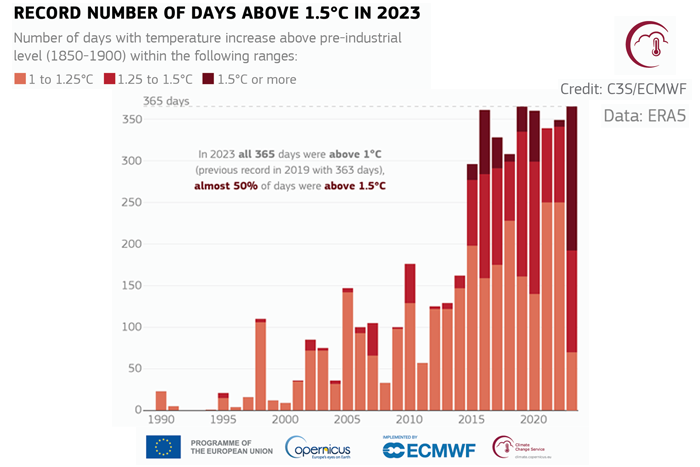Global Climate Highlights 2023
All days in 2023 were more than 1ºC above the pre-industrial level

Global temperatures: 2023 warmest year on record, close to 1.5°C above pre-industrial level
2023 has replaced 2016 as the warmest calendar year on record. According to the ERA5 dataset, the global average temperature for 2023 was 14.98°C, 0.17°C higher than recorded for 2016.- 2023 is confirmed as the warmest calendar year in global temperature data records going back to 1850
- 2023 had a global average temperature of 14.98°C, 0.17°C higher than the previous highest annual value in 2016
- 2023 was 0.60°C warmer than the 1991-2020 average and 1.48°C warmer than the 1850-1900 pre-industrial level
- It is likely that a 12-month period ending in January or February 2024 will exceed 1.5°C above the pre-industrial level
- Each month from June to December in 2023 was warmer than the corresponding month in any previous year
- July and August 2023 were the warmest two months on record. Boreal summer (June-August) was also the warmest season on record
- In September 2023, the temperature deviation above the 1991–2020 average was larger than in any month in any year in the ERA5 dataset (0.93°C higher than the 1991-2020 average)
- October, November and December 2023, each with a temperature of 0.85°C above average, ranked all joint second-largest in terms of temperature deviation above the 1991–2020 average
All days in 2023 were more than 1ºC above the pre-industrial level
2023 marks the first time on record that every day within a year has exceeded 1°C above the 1850-1900 pre-industrial level for that time of year. Close to 50% of days were more than 1.5°C warmer than the 1850-1900 level, and two days in November were, for the first time, more than 2°C warmer.
The approach of the climate system towards the 1.5°C and 2°C limits of the Paris Agreement is usually discussed for temperatures that have been averaged globally and over each year of one or more decades. Observational datasets whose coverage includes the 1850-1900 reference period have monthly resolution, however, enabling estimates to be made of the annual variation in the warming from 1850-1900 to the recent past. This provides a basis for monitoring the accumulation of daily exceedances of the warming limits using reanalysis datasets such as ERA5.
Using ERA5, this monitoring shows that all days of 2023 had global temperatures more than 1°C warmer than the 1850-1900 level for that time of year. Two days were more than 2°C warmer than 1850-1900, the first time the 2°C level has been exceeded. Close to 50% of days in 2023 were in excess of 1.5°C warmer than 1850-1900. This was the case for just over 20% of days in 2016, the previous warmest year on record. The earliest period in ERA5 with daily temperatures successively at least 1.5°C warmer than 1850-1900 is 2-15 December 2015.
Extreme events around the world
- A large number of extreme events were recorded across the globe, including heatwaves, floods, droughts and wildfires.
- Estimated global wildfire carbon emissions in 2023 increased by 30% with respect to 2022, driven largely by persistent wildfires in Canada
Extreme events around the world in 2023 had significant impacts on human health, ecosystems, nature and infrastructure. Among the most exceptional were flooding, wildfires, drought and extreme heat.
Impactful flooding events ranged from flash floods caused by intense rainfall, to large-scale flooding due to the passage of atmospheric rivers (such as in California in January and March, and over Chile in July), monsoon rainfall, large low-pressure systems and tropical cyclones. Cyclone Freddy impacted southeast Africa (February, March), Cyclone Mocha south and southeast Asia (May), Hurricane Hilary Mexico and the western USA (August), Hurricane Otis Mexico, (October), Storm Daniel the Mediterranean (September), and post-tropical cyclone Jasper Australia, (December), among others. In some cases, such as in the Horn of Africa during Autumn, flooding may have been exacerbated by particularly low soil moisture levels that favoured and accelerated runoff.
Many other regions across the globe suffered from prolonged lack of precipitation, in particular in North (Mexico) and South America (Amazon basin, Pantanal wetlands, Argentina, Uruguay) and western Africa. Heatwaves occurred around the world during 2023, often breaking national or local temperature records. Significant occurrences in southern Europe, North Africa, and parts of North America and Asia, were followed in seasonal progression by occurrences over parts of South America, southern Africa and Australia.
Hot and dry conditions in some regions also contributed to extensive wildfires, notably in southern Europe, Canada (in particular the Northwest Territories, and with significant contribution to global carbon emissions), South America, Australia and Hawaii, among others.
Source: Copernicus





